 Interior Design/Interior Decorating
Interior Design/Interior Decorating
Interior Decorating: 3 Steps to Picking the Perfect Color
|
 Interior Design/Interior Decorating
Interior Design/Interior Decorating
|
 Interior Design/Interior Decorating
Interior Design/Interior Decorating

If you’re like most buyers, selecting a sofa is confusing and overwhelming because you have no idea how to select one that’a high quality, the right size, and a style that will last. Read on for my five secrets to selecting a quality sofa with staying power that’s just right for you.
Pick the right size – Before shopping start by taking measurements of your room and the other furniture to be used. Then create a floor plan that allows ample space for walkways (3-4 feet) between furniture groupings and walls. Also take into consideration the height or scale of your room along with the other furniture to be used. In addition all of us are unique in our proportions so selecting a sofa that fits your body is key to being comfortable long term on your sofa. Considerations include sofa height, seat height, seat depth, and length if you’re planning to take an occasional nap.
Choose a style with staying power – The sofas with the most staying power often have simpler lines and less trendy details. Avoid trendy looks that may look dated quickly.
Photo courtesy of Baker furniture
Quality construction – Sofas of high quality often have similar attributes in how their frames, suspension, and cushions are made that not only helps them last longer and hold their shape but also be comfortable. Such attributes may include frames made of kiln dried hardwoods, 8 way tied springs with several coils for suspension that you can feel under the seat cushion, corner blocking for frame reinforcement, mortise and tenon joints, fabric patterns that line up at the seams and much more.
Interior design by Karen Mills
Opt for a solid or tone on tone neutral color- By opting for a solid fabric with little or no pattern, you’ll not only tire of the sofa less quickly but you’re also more likely to be able to re purpose your sofa as you change homes or interiors.
Select durable fabric – High performance fabrics are becoming a big hit with interior designers because they won’t fade quickly and spills just bead up. Other durable fabrics can include wool, velvet, some cottons or linens, acrylic, and some blends of natural/man made materials.
Photo courtesy of Bernhardt furniture
Select durable fabric – High performance fabrics are becoming a big hit with interior designers because they won’t fade quickly and spills just bead up. Other durable fabrics can include wool, velvet, some cottons or linens, acrylic, and certain blends of natural/man made materials.
For more information on how to select a quality sofa for you, contact a qualified interior designer that serves your area.
For more great tips sign up for our weekly interior design blog here
Plus become a fan of Kansas City’s interior designer and former host of Living Large, Karen Mills, on Facebook here!
 Interior Design/Interior Decorating
Interior Design/Interior Decorating
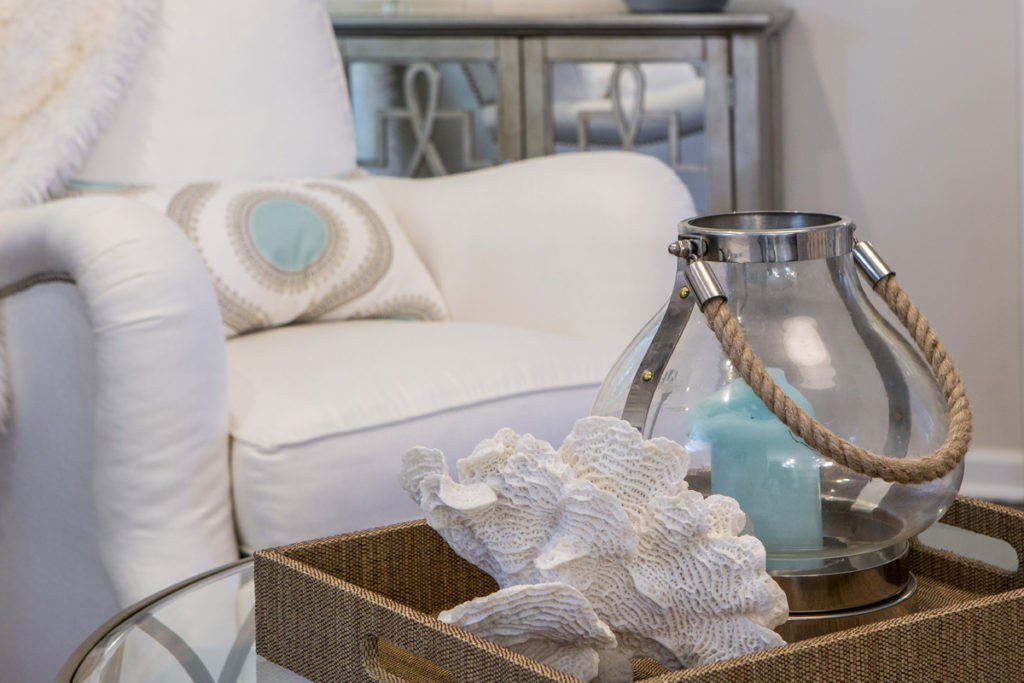
Do you ever feel like your room is unfinished or undone? Do you have all the furniture purchased for your room, but don’t know what to do next and you’re on a modest budget? Here are 3 ways I recommend as an interior designer to inject personality and interest to your space while staying on a reasonable budget.

2. Inject pattern – Introduce pattern with fabrics, draperies, or pillows like this photo of a nursery we decorated on a budget as a surprise for parents from Community America Credit Union. The horizontal stripes of the wall done by the homeowners add dramatic pattern along with the draperies and row of frames we hung with the baby’s initials.

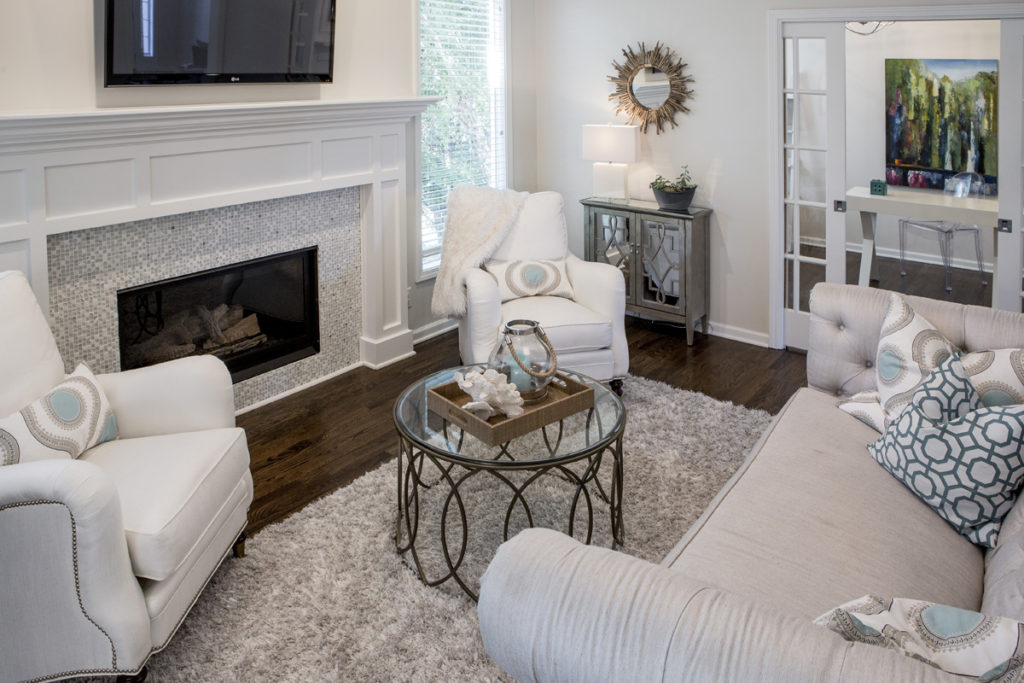
3. Layer in texture – Texture can come through rugs or throws like the room here along with pillows and draperies. Additional texture was added in this room with the small marble tile mosaic inset in the fireplace surround.
In the photo of the nursery, texture was introduced with the pouf, area rug, and fuschia colored pillow. And in the close up of the tray, texture is added with the shell, rope handle, and tray.
For more tips and photos, sign up for our weekly interior design blog here
Or become a fan of Kansas City’s interior designer and former host of Living Large design show, Karen Mills, on Facebook here!
 Interior Design/Interior Decorating
Interior Design/Interior Decorating
If you’re thinking about remodeling your basement, consider these 3 tips for creating a beautiful space that doesn’t feel like a typical basement design.

1. Bring in the daylight. When designing your basement, think about ways you can bring natural sunshine further into your space. One of my favorite tricks? Use french doors or glass windows going into the interior rooms that allow the sun to penetrate further and keep them open for entertaining to maximize space.
Other ways to bring in the light could include adding an a large daylight or above ground window, enlarging an existing window or by creating a walk up basement from a daylight basement if possible.
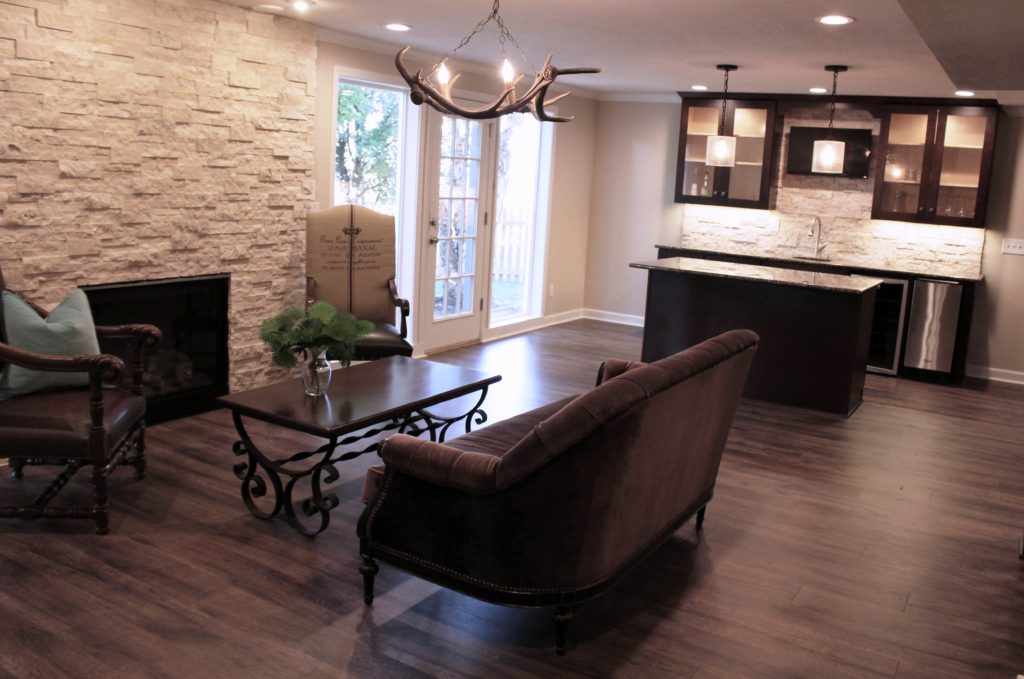
2. Give it importance. Treat your basement space like you would a main level room. Use drywall on the ceilings, add drapery panels over small windows to make them feel grand, and create focal points with architecture, color and/or interior design to give the rooms a “wow” feel. I personally prefer lighter wall colors in a basement that’s dark so it doesn’t feel a cave unless its a home theater area or wine cellar.

3. Beef up your artificial lighting. By adding extensive artificial light with wall washers, accent lighting and/or directional strip lights in addition to your standard lighting, you’ll find that your basement feels more like an upstairs living space.
For more basement remodeling ideas and more, sign up for our weekly interior design blog here
plus become a fan of Kansas City’s interior designer and former host of Living Large, Karen Mills, on Facebook here!
 Interior Design/Interior Decorating
Interior Design/Interior Decorating

One common complaint I often hear as an interior designer is that contemporary rooms are cold and uninviting. But these spaces are becoming more popular because of their simple lines and often calming effect. Below are 3 ways to warm up your contemporary style room.
1. Color not only warms up an interior but can also add drama like this room above where the lime green pillow provides a dramatic contrast against the blue sofa. The live branches also warm up the room.

2. Live Elements are wonderful because they add life and energy to a space whether its a plant, flowers, fruit or other element. As an interior designer, my favorite way to bring life to a space is by introducing flowers, especially exotic ones like orchids that can last for months.

3. Texture can be layered in throughout your room in a variety of ways. Here above the pillows, wall finish, and hanging branch warm up the room nicely along with the warmth of the area rug underneath. Other creative ways to add texture include wood ceilings/walls, rustic finishes, draperies, and/or furnishings with a textural component.
For more great ideas and photos, sign up up for our weekly interior design blog here
Plus become a fan today of Kansas City’s interior designer and former host of Living Large, Karen Mills, on Facebook here.
 Interior Design/Interior Decorating
Interior Design/Interior Decorating
Like any project that involves money, you need a budget or at least a range before you start. Do some research or bring in the experts – an interior designer, contractor/builder, and/or architect – to give an estimated investment.
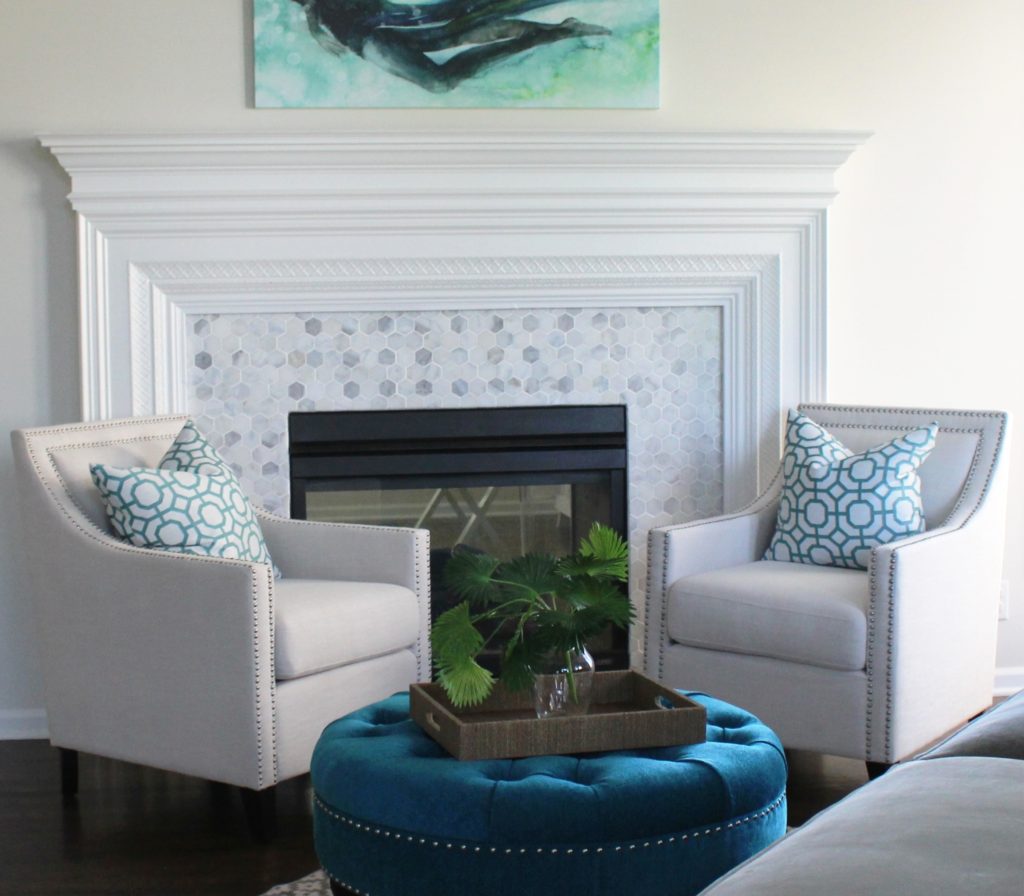
2. Determine your color scheme ensuring it coordinates with adjoining rooms and any existing furnishings to be used in the interior design. If you have no idea, take a look in your closet to see what colors you’re drawn too or pull colors out of an inspiration piece such as art, a rug, or fabric.
3. Create a floor plan so you know what fits in your space and the sizes you need. To do that go online and use space planning software or get an expert to help.
4. Set a timetable. At this point you might want to bring in an expert – interior designer and/or contractor/builder- to review your design plan/timetable because investing a few dollars for a master plan and viable timetable can help avoid thousands of dollars in costly mistakes from bad decisions or huge delays.
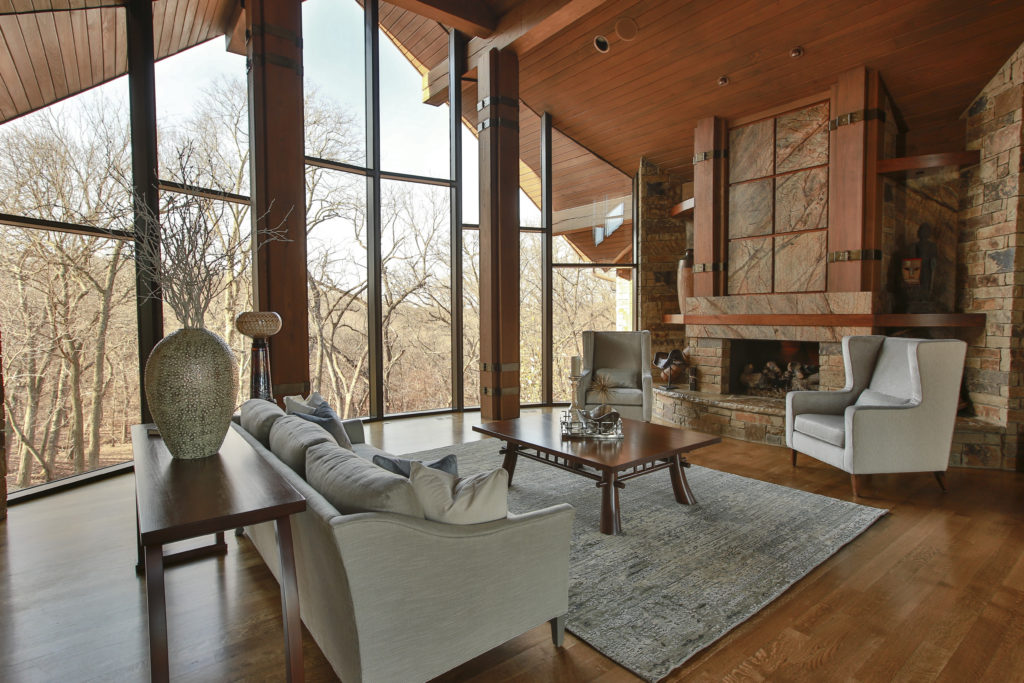
5. Design and order custom furniture and any built in cabinetry after consulting with your interior designer or tradespeople if you’re managing the project yourself. At this point all custom designs need to be finalized and ordered. In addition permits need to be pulled for construction.
6. Select and order all plumbing, flooring, tile, and general lighting needed.

7. Design any custom draperies, bedding, rugs, wall/floor/ceiling finishes, or pillows needed along with choosing hard window coverings, light fixtures, and any ready made furnishings. Then order.
8. Purchase artwork, hardware pulls, lamps, and all other furnishings needed.
For more great ideas and photos, sign up for our weekly interior design blog here
Plus become a fan of Kansas City’s interior designer and former host of the long running Living Large design show, Karen Mills, on Facebook here!
 Interior Design/Interior Decorating
Interior Design/Interior Decorating
 Interior Design/Interior Decorating
Interior Design/Interior Decorating

The romantic lure of the rustic style home or cabin is undeniable. Maybe its because of our rich heritage of building log cabins to protect our families from the weather. Or maybe its the way rustic homes connect us with the outdoors with their rough hewn beams, simple style, and organic materials like stacked stone fireplaces.
But even though we still love our rustic home, sometimes we crave furnishings that are more refined and luxurious to offset the rugged architecture for that perfect mix of masculine and feminine. If that’s you, here are my 3 tips as an interior designer to help you create a beautiful blend.
Layering in an area rug with an organic pattern in those same hues brings everything together while the lighter colors of all the furnishings help bounce around much needed light in the room.

2. Keep it simple Because of the rugged nature of the rustic interior, to create a sophisticated feel its important to balance the mega sized fireplace, wood columns, and other rough elements with furnishings with cleaner lines and softer edges to create the perfect balance of rugged and sleek. Here the softer lines of the sofa and tables help balance the rough hewn fireplace and stone columns.
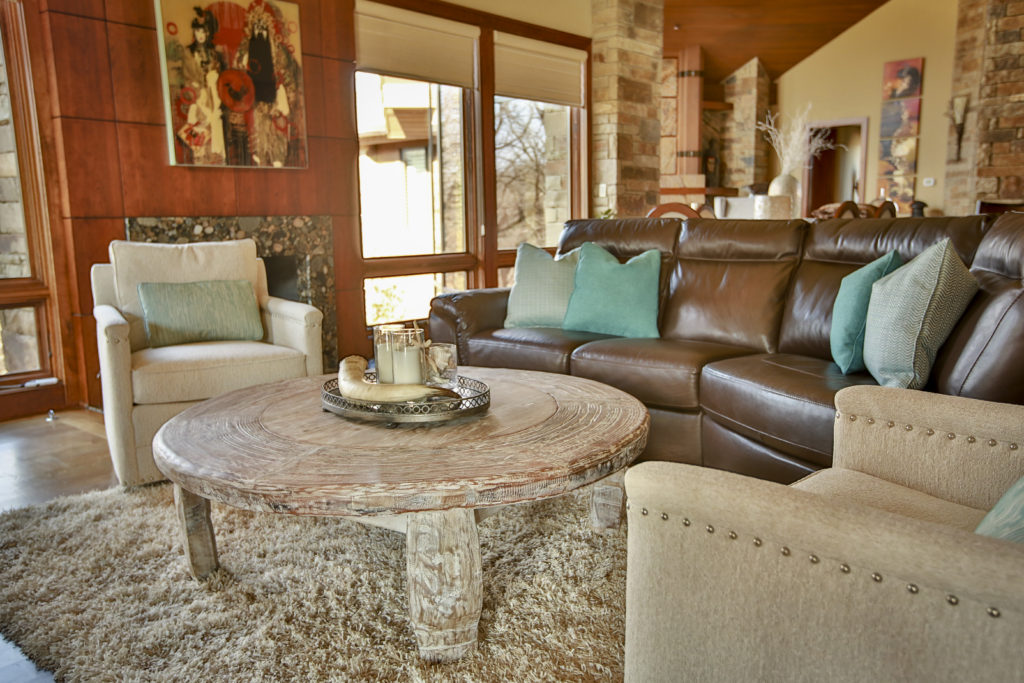
The same is true with this family room where the textural pillows, shag rug, and airy swivel chairs add texture and light to the darker hard surfaces of the fireplace, floors, and leather sofa.
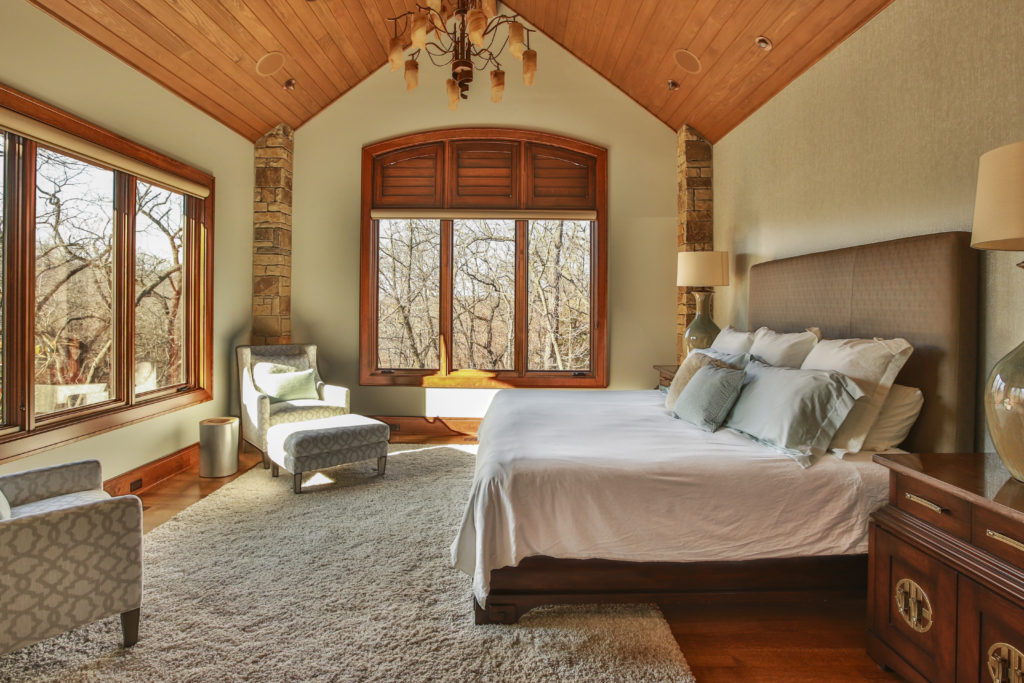
3. Layer in organic materials that coordinate with the room’s rugged finish to soften room such as natural cottons as seen in the bedding and the casual fabrics on the chairs. The textural rug also adds light and interest to the room.
A beautiful simple pale blue shimmery wallpaper in an organic pattern provides a nice juxtaposition against the stone columns and paneled wood ceiling.
For more great tips and photos sign up for our weekly interior design blog here
Plus become a fan of Kansas City’s interior designer and former host of Living Large, Karen Mills, on Facebook here.
 Interior Design/Interior Decorating
Interior Design/Interior Decorating
If you love acrylic furniture check out the Associated Press article I was recently featured in that’s already made appearances in ABC, The Washington Post, Yahoo and many more titled Clear Favorite: Acrylics a Versatile Furniture Option .
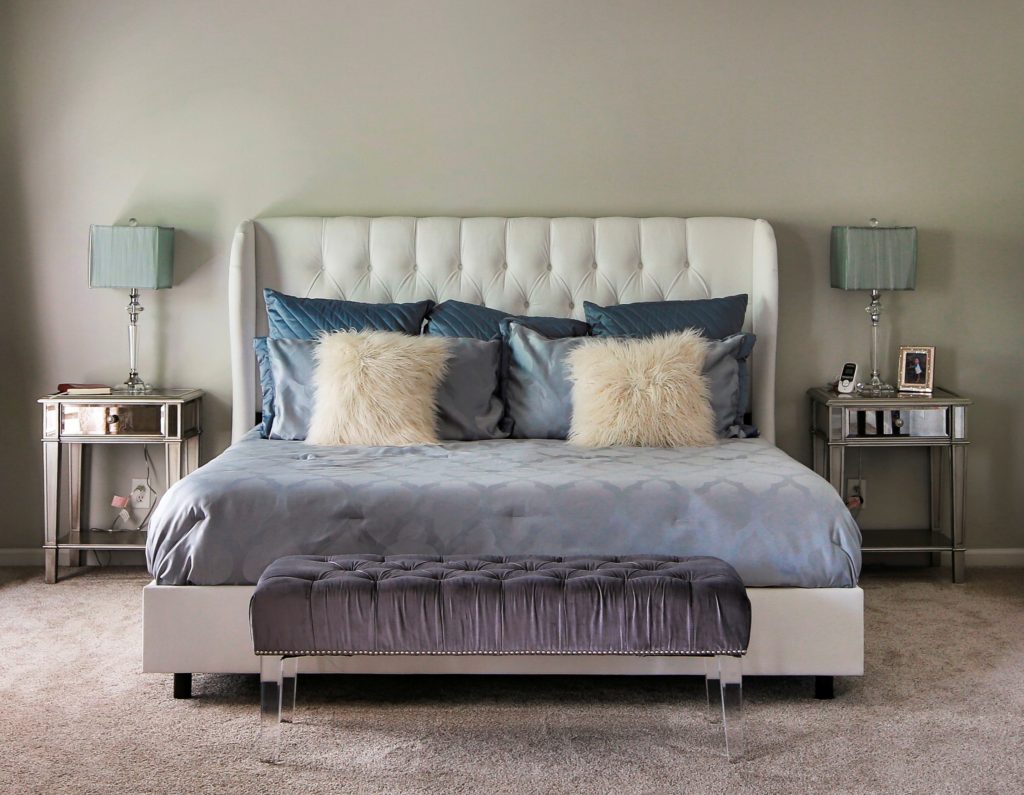
Our project in this photo that was part of the Associated Press article shows how acrylic furniture can be used in a room effectively which I also talk about in the interview link above.

Coffee tables and nesting end tables are one of my favorite pieces to use in a project too, especially in a smaller space like this photo where they don’t take up room visually but still serve a function.

Dining rooms like this photo offer another opportunity to include acrylic whether its the table, chairs, or a bar cart. Here the Century table almost disappears in the room keeping the space light and airy.

For more great tips and photos, sign up for our weekly interior design blog here
Plus become a fan of Kansas City’s interior designer and former host of the Living Large design show on Facebook here!
 Interior Design/Interior Decorating
Interior Design/Interior Decorating
The first day of spring has arrived in the United States and it’s a joyous time for most of us in the colder climates because it marks the end of a season of cold, ice, and snow.

As I walked through my yard this last weekend I saw green buds appearing everywhere from bushes and trees to perennials. So of course that motivated me to perform my semi-annual tradition of packing up heavy winter decor and ushering in spring with lighter decor. If you would like to lighten your interior too, here are 5 tips for injecting spring into your home.
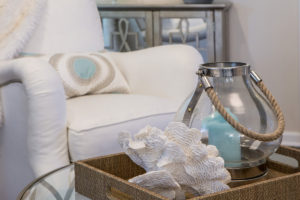
2. Add fresh pops of color in pillows and decor like the room above. The shell and lantern beach inspired decor also add to the warm season feel.

3. Replace dark heavy items like rugs with lighter options like shown above or go with a natural rug like a sisal. If that’s not possible, opt for removing the rug altogether.
Light pillow covers in natural fabrics also add to the appeal along with fresh flowers and light upholstery. If you don’t have light upholstery, consider adding a slipcover for spring/summer weather like the dining chairs we had slip covered below.
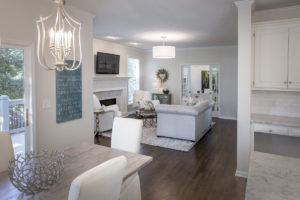

4. Lighten up in the bedroom by replacing heavy dark bedding with light natural fabrics in cotton and consider using sheer drapery panels instead of heavy drapes.
5. Spring Clean Remove all the extra items that have accumulated over the winter months and do some spring cleaning so your room feels fresh and fabulous. Now you’re ready for spring!
For more great photos and tips, sign up for our weekly interior design blog here!
Plus become a fan of Kansas City’s interior designer and former host of Living Large, Karen Mills, on Facebook here!